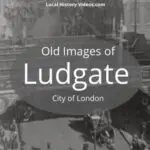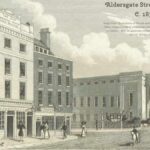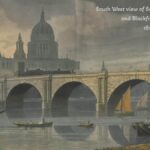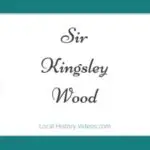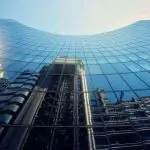Glimpse history through old images of Ludgate Hill, in the historic city of London.
Where did Ludgate get its name?
It’s generally accepted that Ludgate got its name from an old English term, the compound of hlid (opening) and geat (gate) which are put together to mean postern or swing gate,
How old was the Ludgate?
It’s though that the Romans were probably the first to build the Ludgate, possibly named after an early kind of Britain. Around 1136, Geoffrey of Monmouth mentioned Ludgate in his Historia Regum Britanniae, suggesting it was named after the mythic Welsh king Lud, son of Heli.
In 1760, the old Ludgate and attached gaol were torn down, with St Paul’s Cathedral build on the site. The church of St. Martin’s once attached to the Ludgate, still stands.
Ludgate Hill
Ludgate Hill, Tower Hill and Cornhill are three ancient hills of London.
There’s also a street called Ludgate Hill which runs between the churchyard at St Paul’s Cathedral, and Ludgate Circus, a road junction where Farringdon Street/New Bridge Street crosses Fleet Street/Ludgate Hill.
The narrow streets and alleys of Ludgate Hill disappeared in the mid 1860s.
- Lugate Street was widened, becoming Fleet Street
- Ludgate Circus was built in 1864
- Ludgate Hill railway station was built between Water Lane and New Bridge Sreet
Publishing
Ludgate Hall was a centre of printing, journlaism and printing from the 1500s through to the mid-1900s. Books, arts prints, newspapers, satirical pamplets and lottery tickets were all produced in the local shops and printing workshops.
Ludgate Hill in 1896
First, here’s an old photograph of Ludgate Hill, taken in 1896, when Queen Victoria was the British monarch.
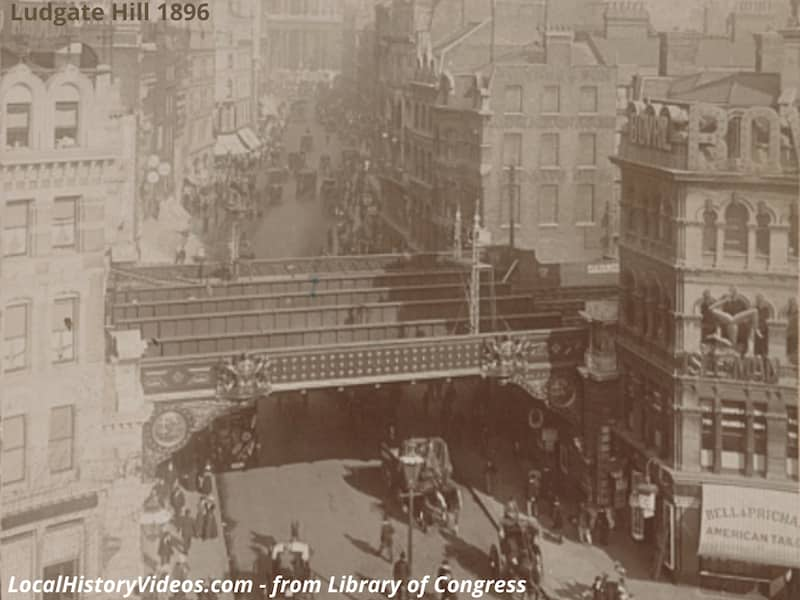
Now we’ll see a series of closeups of the 1896 photo, to spot many interesting and curious details. Just click on the top half of the image to display a larger version.
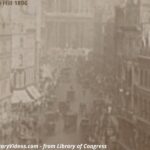
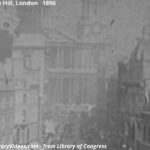
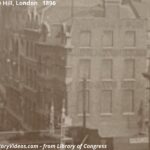
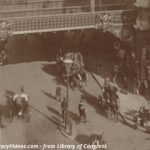
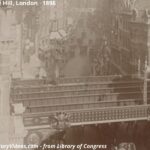
Lugate Hill 1901
This photo was taken in 1901, just as a steam train passed above the street packed with pedestrians and horse driven carriages.
Through the steam, you can just make out the domed roof of St Paul’s Cathedral, and the spiked roof of St Martin’s Ludgate. Both of these historic places of worship were designed by Sir Christopher Wren in the 1600s.
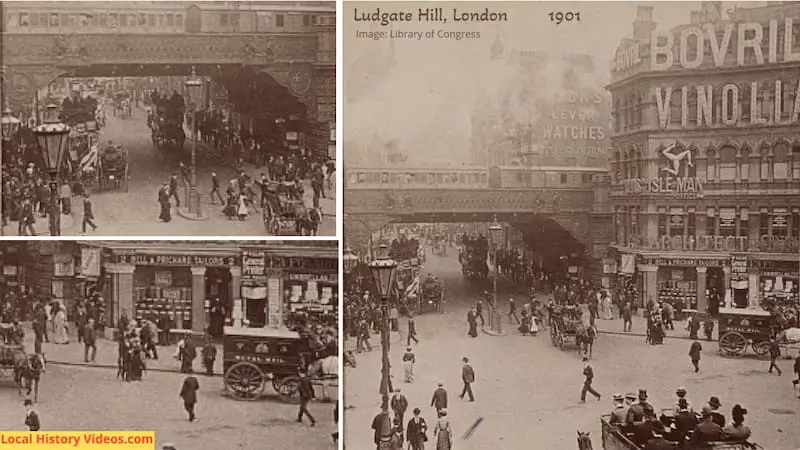
20th Century Developments
Ludgate Hill railway station closed to passengers in 1929.
In 1990, the railway bridge and viaduct were demolished, allowing construction of the City Thameslink railway station.
The London Stock Exchange has been located on Paternoster Square since 2004.
Ludgate Hill In An Old Book
Extract from “London, Past and Present – Its History, Associations, and Traditions · Volume 2“, by Henry Benjamin Wheatley and Peter Cunningham
Published in 1891
Pages 447 – 448
Ludgate Hill and Ludgate Street, portions of the main artery of London leading from Fleet Street to St. Paul’s: the latter term is now abolished, and it is named Ludgate Hill throughout.
The hill extended from Fleet Street to the site of old Ludgate, and the street thence to St. Paul’s churchyard.
The old name for the street was Bowyer Row. [ See Ludgate. ]
The hill was often called Paul’s.
On March 24, 1603, the day of Elizabeth’s death, Manningham the Diarist says, “The Lord Hunsdon was in Paule’s Hill beyond Ludgate to attend the Proclamation.”
Betwixt the south end of Ave Mary Lane and the north end of Creed Lane is Bowyer Row, of bowyers dwelling there, now worn out by mercers and others.- Stow, p. 127.
Observe. Church of St. Martin’s, Ludgate, on the north side; and on the south side, in St. Martin’s Court, one of the few remaining fragments of London Wall.
On the south side was Everington and Graham’s magnificent shawl shop; and on the north side, at the sign of the Golden Fish, was Rundle and Bridge’s, the great jewellers, gold smiths, and silversmiths, two of the most distinctive of the London shops of the past half century.
Both are gone, and in losing them Ludgate Hill lost something of its dignity of character, which has not been altogether supplied by the costly new shops and offices on both sides of the way.
On the north side also was the Bell Savage Inn (see that title), and, by No. 28, is Stationers ‘ Hall Court, leading to Stationers ‘ Hall.
The Dog Tavern, and the St. John’s Head, in the olden times a tavern of very great note, have quite disappeared.
June 1620. – Certificate that Edm. Jeakell’s shop, next the west gate of St. Paul’s was not pulled down when the King visited the Church, but that, not having time to decorate it, he was compelled to drive in the fore part of it. – Cal. State Pap., 1619-1623, p. 158.
Evelyn writing to Sir Thomas Browne, January 28, 1658, says: “Your letters will infallibly find me by this addresse, ‘ For Mr. John Evelyn at the Hauk and Feasant on Ludgate Hill, London, ‘ ” and in April 1659 we find him, in writing to Robert Boyle, still asking for letters to be addressed to him at “the Hauk and Feasant upon Ludgate Hill, at one Mr. Saunders, a woollen draper.”
In the 17th century Ludgate Hill was a fashionable place for ladies shopping.
In 1657 the Lady Ann Hambleton ( Mrs. Carnegy ) and Mrs. Barbara Villiers write to the second Earl of Chesterfield: My Lord – My freind and I are just now abed together, contriving how to have your company this afternoon. If you deserve this favour, you will come and seek us at Ludgate Hill, about three a clock, at Butler’s shop, where we will expect you.- Chesterfield Letters, p. 88.
At the top of Ludgate Hill, and in front of the Bishop of London’s palace [see London House], Digby, R. Winter, Grant, and Bates were executed, January 30, 1606, for their participation in the Gunpowder Plot.
The views from Ludgate Hill, looking down the busy thorough fare of Fleet Street, and from the lower part upwards with the tower of St. Martin’s and the west front and dome of St. Paul’s were exceedingly interesting and picturesque, but have been greatly destroyed by the erection of the bridge which carries the London, Chatham, and Dover Railway across the hill foot.


